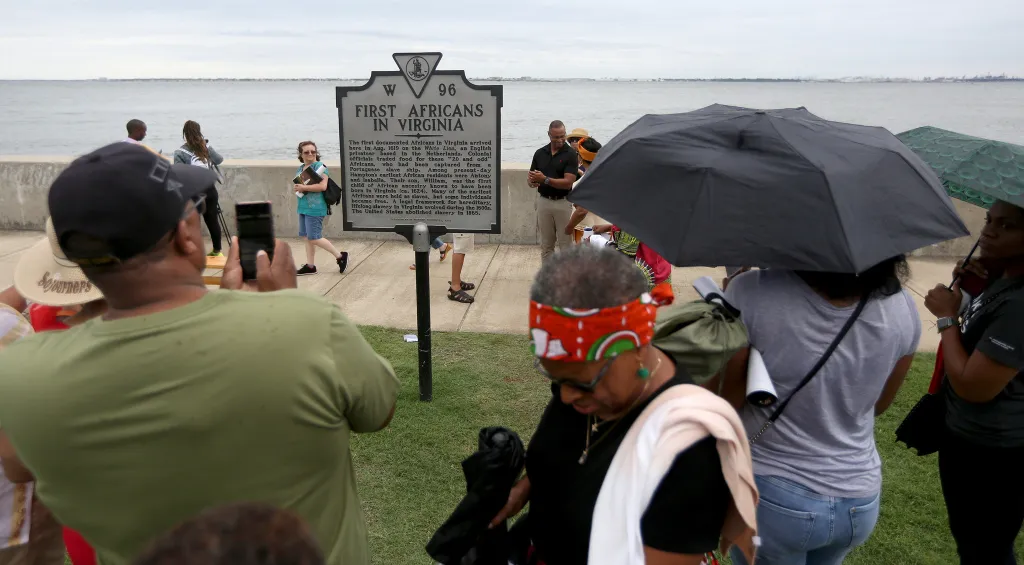
HAMPTON — Fort Monroe has no plans to change any of its exhibits or signage pertaining to slavery as several other national parks have reportedly done in order to comply with a federal order discouraging “corrosive ideology.”
The Washington Post reported last week that several national parks had flagged exhibits for removal ranging from a historic photo of a formerly enslaved man with scars on his back to information about abolitionist John Brown.
Point Comfort, where Fort Monroe stands today, is the location where the first enslaved Africans were brought in English North America in 1619 — their arrival marking the beginning of 246 years of slavery in the United States.
According to Fort Monroe Authority CEO Scott Martin, the National Park Service has not flagged anything for removal, and unlike many historic sites, many parts of Fort Monroe are not under NPS jurisdiction.
“Most interpretive signage at Fort Monroe is on commonwealth of Virginia property, so any actionable changes in signage on commonwealth of Virginia lands would come from one of two places: either the Fort Monroe Board of Trustees or the Secretary of Commerce and Trade, whom I report to,” Martin said. “I’ve received no guidance from either one of those to make any changes on lands or signs owned by the commonwealth of Virginia.”
The Army decommissioned Fort Monroe in 2011, and over the years since, much of the land has been deeded back to the state.
President Donald Trump issued an executive order in March directing the Interior Department to take down exhibits that “inappropriately disparage Americans past or living” or promote a “corrosive ideology,” especially on topics such as race. Following the order, Interior Department Secretary Doug Burgum released an order in May laying out plans to transform U.S. national parks.
Under the plan, each land management bureau had 30 days to review and flag materials changed under the Biden administration and 60 days to submit a report of their findings to their Assistant Secretary. The bureau had 90 days to review all national parks for “inappropriate content,” described as “images, descriptions, depictions, messages, narratives or other information (content) that inappropriately disparages Americans past or living (including persons living in colonial times).” Any exhibits deemed inconsistent with the executive order were to be removed within 120 days.
The deadline to remove inconsistent exhibits and signage was Sept. 20.
Martin said a lot of Fort Monroe’s acreage belongs to the National Park Service as part of the national monument. However, most of the “interpretive stuff,” including the Casemate Museum, which displays the fort’s military history, the Visitor and Education Center, and the site which will become the African Landing Memorial in the coming months, all reside on commonwealth land.
The memorial, several years in the making, will depict the capture and enslavement of Africans in Angola, and their travel to modern day Fort Monroe where they were traded as property into slavery.
During the Civil War, the fort became a refuge for escaped slaves seeking freedom after a Union commander there declared three escaped enslaved men “contraband” and refused to return them to Confederates.
National Park Service spokesperson Elizabeth Peace said in a statement the department is implementing the secretary’s order to carry out Trump’s executive order, and conversations are still ongoing about how that could relate to Fort Monroe. She declined to comment further.
The Fort Monroe Foundation and Project 1619, which helped create the African Landing Memorial, declined to comment. The Bureau of Land Management did not respond for comment.
Other parks haven’t been as fortunate.
The Post reported that national park service staff had flagged roughly 30 signs discussing racial discrimination for removal at Harpers Ferry National Historic Park, the site where abolitionist John Brown sought to organize an armed rebellion against slavery. Park officials have also ordered the removal of a photograph known as “The Scourged Black” at Fort Pulaski National Monument in Georgia, according to the New York Times. The famous photo shows a man’s heavily scarred back from whippings he endured while he was enslaved, and was circulated during the abolitionist movement to show northerners the horrors of slavery.
Additionally, Trump highlighted Independence National Historic Park, where the founding fathers signed the Declaration of Independence, and the Smithsonian for creating exhibits covering race-related topics.
For now, Martin said he and his team are focused on pushing forward on their plans to transform Fort Monroe into a park that honors the military and cultural history of the site.
“Great public places begin with land, and don’t lie,” Martin said. “Landscapes last hundreds of years, so we’ve got a little bit different of a timeline and a horizon that we’re thinking about right now.”
Devlin Epding, 757-510-4037, devlin.epding@virginiamedia.com



